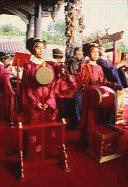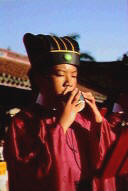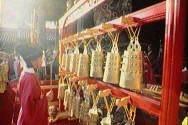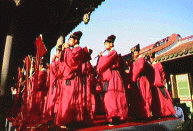 |
Traditional Chinese Music |

A
Flower Moon Night on Spring River puts the listener in a happy mood, as though
he were looking at a graceful Oriental landscape painting; Mournful Autumn makes
one feel the inner sorrow of a bleak autumn day; Ambushed From Ten Sides
deposits the listener on a thunderous ancient battleground; All the World
Rejoices stirs up a joy of celebration in whoever happens to get caught up in
its festive rhythms. These are famous examples of traditional Chinese musical
compositions, all of which can transport the listener into a whole new sensory
world.
 The origins of Chinese music, or
traditional Chinese music can be traced back to distant antiquity. Around 3,000
years ago, when European music was just experiencing its first rustlings of
life, a complete musical theory and sophisticated musical instruments began
appearing in China, owing largely to the orthodox ritual music advocated by
Confucius. By the Han Dynasty (206 B.C.-220 A.D.), the imperial court set up a
Music Bureau, which was in charge of collecting and editing ancient tunes and
folk songs. Because of commercial contacts with Central Asia, foreign music
entered China in the form, for example, of the p'i-p'a , or lute, and the
hu-ch'in , a vertically-held violin. Influenced by this foreign-originating
music, composers of the time modified and improved Chinese music. By the time of
Emperor Shaun Tsung (r. 713-755 A.D.) of the T'ang Dynasty, the court organized
the Pear Garden Academy song and dance troupe, cultivating a large number of
musicians, and thus laying a firm foundation for Chinese music. The origins of Chinese music, or
traditional Chinese music can be traced back to distant antiquity. Around 3,000
years ago, when European music was just experiencing its first rustlings of
life, a complete musical theory and sophisticated musical instruments began
appearing in China, owing largely to the orthodox ritual music advocated by
Confucius. By the Han Dynasty (206 B.C.-220 A.D.), the imperial court set up a
Music Bureau, which was in charge of collecting and editing ancient tunes and
folk songs. Because of commercial contacts with Central Asia, foreign music
entered China in the form, for example, of the p'i-p'a , or lute, and the
hu-ch'in , a vertically-held violin. Influenced by this foreign-originating
music, composers of the time modified and improved Chinese music. By the time of
Emperor Shaun Tsung (r. 713-755 A.D.) of the T'ang Dynasty, the court organized
the Pear Garden Academy song and dance troupe, cultivating a large number of
musicians, and thus laying a firm foundation for Chinese music.
The variations of rhythm, beat, tone
quality, and embellishments in traditional Chinese music are highly distinctive
and unlike their Western counterparts. This is mainly due to the unique sounds
and playing styles of traditional Chinese musical instruments.
 Chinese musical instruments can be
divided into four basic categories based on the method by which they are
played:" blown," "bowed," "plucked," and "struck" (i.e. percussion) instruments. Chinese musical instruments can be
divided into four basic categories based on the method by which they are
played:" blown," "bowed," "plucked," and "struck" (i.e. percussion) instruments.
The development of traditional
Chinese music in the Taiwan on Taiwan can generally be divided into two
categories. The first developed from the traditional music played by folk
performing groups, usually composed of three to five or at most ten people. The
performers are generally of advanced age, and they play mostly folk tunes or
themes from traditional Chinese operas. This kind of music gives the listener a
good feel for the rhythms of day-to-day Chinese rural life. The modern version
of the Chinese "orchestra," comprised of dozens of different types of Chinese
instruments, developed in response to changes in society. Besides performing
traditional Chinese music, the Chinese orchestra plays adapted versions of folk
songs along with classical and modern symphonic compositions. It is widely
favored by young music lovers.
 There
are currently three professional orchestras in the Taiwan on Taiwan that give
frequent public performances of Chinese music: the Taipei Municipal Orchestra,
the Chinese Music Orchestra of the Broadcasting Corporation of China (BCC), and
the Experimental Chinese Orchestra of the National Taiwan Academy of the Arts.
Most of the members of these orchestras were trained in departments of
traditional Chinese music of local universities and colleges. In addition to the
technical music training they receive, they also study traditional music under
the guidance of elderly folk performers. In this way, they preserve and pass on
tradition while carrying out musical research and development. Outside of the
three professional orchestras, there are over 200 amateur and school orchestras.
And classes on traditional Chinese musical instruments are held in elementary,
junior high, and senior high schools, a further reflection of the popularity of
Chinese music in Taiwan today. There
are currently three professional orchestras in the Taiwan on Taiwan that give
frequent public performances of Chinese music: the Taipei Municipal Orchestra,
the Chinese Music Orchestra of the Broadcasting Corporation of China (BCC), and
the Experimental Chinese Orchestra of the National Taiwan Academy of the Arts.
Most of the members of these orchestras were trained in departments of
traditional Chinese music of local universities and colleges. In addition to the
technical music training they receive, they also study traditional music under
the guidance of elderly folk performers. In this way, they preserve and pass on
tradition while carrying out musical research and development. Outside of the
three professional orchestras, there are over 200 amateur and school orchestras.
And classes on traditional Chinese musical instruments are held in elementary,
junior high, and senior high schools, a further reflection of the popularity of
Chinese music in Taiwan today.
 In the area of composition,
musicians are experimenting with incorporating elements from other musical
systems and introducing creative innovations while preserving the spirit of
traditional music, thus infusing Chinese music with a whole new vitality. In the area of composition,
musicians are experimenting with incorporating elements from other musical
systems and introducing creative innovations while preserving the spirit of
traditional music, thus infusing Chinese music with a whole new vitality.
|
 |



